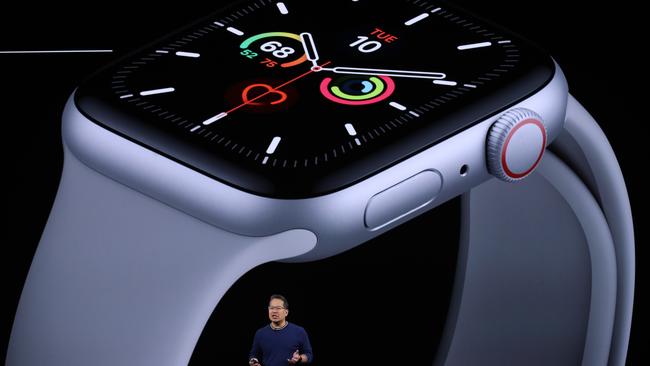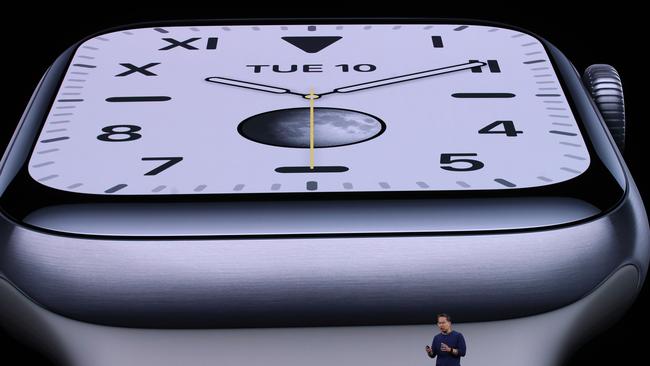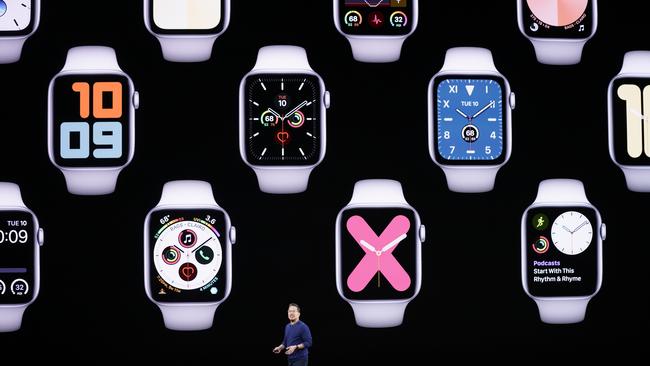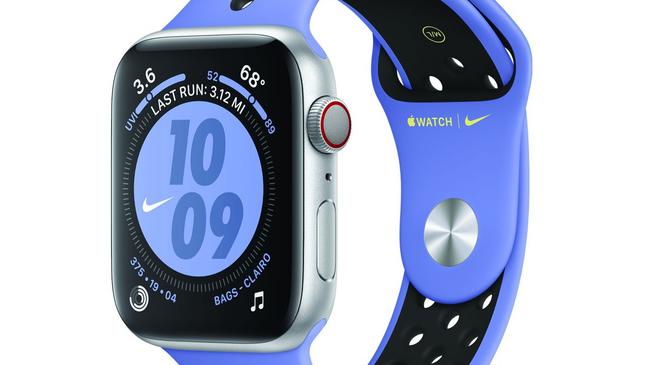Time for an Apple Watch change
The new Apple Watch is out, with more features than ever.

Apple Watch has been the quiet achiever of the tech giant’s line-up. Sales have never soared to the heady height of the iPhone, but Apple Watch is the dominant player in a booming smartwatch market.
Figures by US market research firm the NPD Group show that in the 12 months to November last year, with 88 per cent market share, watches by Apple, Samsung and Fitbit are blitzing traditional watch manufacturers.
Apple Watch has been the most popular smartwatch in Australia in the past three years, Telsyte managing director Foad Fadaghi says. It’s the most used smartwatch — and arguably the most used watch overall.
“Telsyte estimates more than 770,000 Apple Watches were sold in 2018, up 33 per cent from 2017,” Fadaghi says.
Series 5 emerged last week at Apple’s launch event in Cupertino, California. That’s five generations of Apple Watch since April 2015. Such frenetic development is a great sign of the product’s appeal.

But Apple Watch Series 5 isn’t a radical departure from last year’s Series 4. Sizes and weights are similar, with 40mm and 44mm models (measured by height), and weights dependent on materials. The lightest have aluminium cases and weigh from 30.8g, then come titanium, ceramic and stainless steel casings, with the heaviest Apple Watch weighing 46.7g.
Apple Watch started as an appendage to the iPhone, with Wi-Fi calling. Watches needed to be linked to a phone by Bluetooth.
Series 3 saw cellular-capable Apple Watches produced with their own electronic SIM, breaking the nexus between the watch and phone. You could receive and make calls and send messages without an iPhone nearby. The watch uses the same mobile number as your iPhone, so you don’t miss calls and you don’t need two phone accounts.
The Series 5 keeps this arrangement. It costs an extra $5 a month on a Vodafone account for the Apple Watch calling facility.
Apple promotes the biggest difference between Series 4 and Series 5 as the watch face display being always on. Previously you had to raise and twist your wrist towards you for it to light up. Apple cites situations such as being at a boring meeting and wanting to surreptitiously glance at the time without others deciphering your boredom.

You could be on a treadmill or other exercise machine, hanging on like grim death and unable to twist and raise your wrist.
We shouldn’t jump up and down ecstatically about this. Most of us can twist our wrists to look at the time naturally. And mechanical watches by default have had “always-on displays” since the 16th century.
Nevertheless it’s impressive that Apple has achieved this without degrading overall battery life. It still claims a standard 18 hours battery life per charge. The watch display is dimmer when you are not actively looking at it but you can prod it to brighten it up.
Apple has added a traditional compass to Apple Watch with the addition of a magnetometer. You might think a compass is redundant in the age of Apple and Google Maps. No one asks you to head southeast 117 degrees for 2km when they give you directions.
But a magnetometer can be useful. The iPhone has had them since the 3GS model. Apple Maps and Google Maps have a compass button that reorients a map in the direction you are going. You can always check the way you are facing.
With the compass app also on Apple Watch, you can realign your sense of direction even when a maze of city buildings causes the GPS to misdirect you. Apple says its compass software corrects for true north from magnetic north.
It says Watch apps for tourist attractions and businesses can include a compass arrow that shows you the direction to walk to them. Again, I’m not over the moon about this, given that compasses existed in the second century BC courtesy of China’s Han dynasty. It seems the electronic era of watches has taken its time to catch up. But it helps.

However, I am bullish about the accumulated capabilities of Apple Watch across four years that makes Series 5 attractive. Having helped enslave us to smartphones, Apple has made it possible to ditch the phone and still feel connected to the world.
I can go out walking with only the Apple Watch and a set of decent headphones and not feel digitally naked. I can pay for cappuccinos and croissants using the watch with Apple Pay, although sometimes I feel like Harry Houdini, twisting my wrist and body to align with the shop terminal to register a payment.
I can access loyalty cards, including Woolworths and Coles, using the Stocard app on Apple Watch.
The watch has even more memory for storing music tracks, so there is plenty to listen to en route.
I can ask Siri to make calls, take calls, receive text messages and send message replies. You can select from standard replies, dictate replies or scrawl them out letter by letter using your finger.
I can react to social media notifications with standard responses, and use a plethora of apps for calendar, alarms, activity and fitness monitoring, mail, heart rate monitoring, walkie-talkie, maps, news, checking train and public transport times here and even request a Premium Uber.

Apple has been keen to add medical support functionality to Apple Watch. Press the side button and you can call local emergency services in more than 150 countries. Apple Watch detects if you fall, although I get occasional false positives where the watch thought I was falling because of some sudden, jerky motion of my arm at the time. I am quick to switch off the alarm.
This year there is menstrual cycle tracking for women, and a hearing health app that will alert you if the decibel level has reached 90. I wish I had this at rock concerts in the 1970s.
Apple Watch uses the optical heart rate sensor available on all models to check heart rate and any arrhythmic heart activity. Last year Apple added an ability to take an ECG, but this doesn’t work in Australia as Apple has not yet obtained medical accreditation here for it. It hasn’t indicated any timetable for this to happen.
Apple doesn’t offer blood pressure monitoring on Apple Watch directly, but rival Samsung’s Galaxy Watch Active does. Sleep is an area where Apple Watch isn’t really suited to without longer battery life.
Apple claims water resistance to 50 metres.
One of the biggest innovations isn’t due to Series 5 hardware, rather the rollout of watchOS 6, the operating system for all versions of Apple Watch. There is now a separate Watch app store. Until now, you installed apps through the phone. They new exist independently of iPhone and you install apps from the App Store accessed through the watch.

Apps include Headspace meditation and sleeping, the Yazio easy calorie counter, translation, Kitchen Stories Recipes, Outcast for watch podcasts, Nike Run Club, and more.
I have found it easier managing apps on Apple Watch since changing from grid view, which shows apps as unlabelled circular icons in a big amorphous cloud, to list view. You hard press the screen to change between them.
Apple Watch Series 5 starts at $649 and $699 for GPS-only 40mm and 44mm aluminium models, $799 and $849 for GPS and cellular models, through to more than $2200 for stainless steel Hermes-branded watches. There is a wide range of bands.
Apple has reduced the price of Series 3 watches which you can pick up in Australia starting at $319.
If you hate having a smartphone with you, Apple Watch can take away the pain without you feeling disconnected from the digital world. Apple Watch Series 5 will be available from Friday.
Chris Griffith travelled to the launch event courtesy of Apple.



To join the conversation, please log in. Don't have an account? Register
Join the conversation, you are commenting as Logout